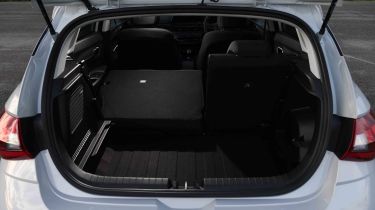Hyundai i20 - Practicality, comfort & boot space
Practicality is one of the Hyundai i20’s strongest suits, and it’s boot volume is near the top of the class

Hyundai’s supermini has had a growth spurt over the last couple of generations, and the latest model is no exception. Growing in every dimension apart from height, with its slightly lower profile combined with greater width to lend the car its sporty proportions. There’s been a small increase in wheelbase to improve cabin room, and little tweaks to the cabin design make this the most accommodating i20 yet.
The usual suite of cubbyholes makes it easy enough to stash stuff around the i20’s cabin, and we approve of the decent-sized glove box, which is far more useful than what you’ll find in a Peugeot 208 and Vauxhall Corsa. The cubby ahead of the gearlever is more than suitable for a mobile phone or two, though, and in Premium models and above, it comes with a charging pad.
Size
The i20 is right in the supermini ballpark, with a length of just over four metres, at 4040mm. It’s also 1775mm wide (excluding mirrors), and 1450mm high, with a 2580mm wheelbase, 10mm greater than its predecessor. For comparison, those figures are within a few centimetres of a Volkswagen Polo in terms of length, marginally wider and around the same height.
Legroom, headroom & passenger space
Being among the largest superminis in the class, the i20 can comfortably accommodate four adults – you might even squeeze four six-footers in there, so carrying a couple of children around is no issue.
As per most of its class rivals, there are a pair of ISOFIX child seat mounting points provided on the outer positions.
Boot
At 352 litres, the i20’s boot is among the largest in its class, and it has the measure of the Peugeot 208’s 311-litre hold. Only the Volkswagen Polo can claim similar space, with an insignificant one-litre difference at 351 litres. Even then, the Hyundai’s 1165-litre seats-down volume is 40 litres greater than that of the Volkswagen.
The rear seats fold in the traditional 60/40 split, as you’ll find with most cars in this class.









